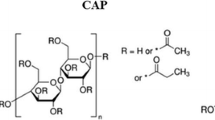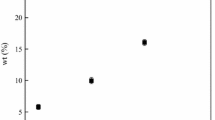Abstract
The addition of cellulose acetate (CA) to a mixed solvent of N,N dimethylacetamide (DMA) and water is examined at different CA concentrations and water contents. Unlike the addition of water to a CA/DMA solution, the addition of CA to a DMA/water solution leads to a transition from a homogeneous solution at low water content to a two-phase system at higher water contents. The two-phase system has an upper liquid layer with an almost clear “solution-like” appearance and a lower gel-like layer. Treating the two-phase system at 100 °C for 30 min results in the formation of a uniform gel structure, similar to that produced by directly adding water to a CA/DMA solution. Although the phase behavior of these systems is similar, their viscoelastic properties are not. The moduli of the heat treated gels do not significantly vary from that of the bottom gel-like portion of the original two-phase samples. This may indicate that thermal treatment at 100 °C is not able to disrupt the pre-established CA intra- and intermolecular interactions and form the stronger CA-DMA interactions.







Similar content being viewed by others
References
Appaw C, Gilbert RD, Khan SA, Kadla JF (2007) Viscoelastic behavior of cellulose acetate in a mixed solvent system. Biomacromolecules 8:1541–1547
Bochek AM, Kalyuzhnaya LM (2002) Interaction of water with cellulose and cellulose acetates as influenced by the hydrogen bond system and hydrophilic-hydrophobic balance of the macromolecules. Macromol Chem Polym Mater 75:989–993
Chauvelon G, Doublier J-L, Buleon A, Thibault J-F, Saulnier L (2003) Rheological properties of sulfoacetate derivatives of cellulose. Carbohydr Res 338:751–759
Gomez-Bujedo S, Fleury E, Vignon MR (2004) Preparation of cellouronic acids and partially acetylated cellournic acids by TEMPO/NaClO oxidation of water-soluble cellulose acetate. Biomacromolecules 5:565–571
Hao JH, Wang S (2001) Calculation of alcohol-acetone-cellulose acetate ternary phase diagram and their relevance to membrane formation. J Appl Polym Sci 80:1650–1657
Kawanishi H, Tsunashima Y, Okada S, Horii F (1998) Change in chain stiffness in viscometric and ultracentrifugal fields: cellulose diacetate in N,N-dimethylacetamide dilute solution. J Chem Phys 108(14):6014–6025
Kawanishi H, Tsunashima Y, Horii F (2000) Dynamic light scattering study of structural changes of cellulose diacetate in solution under couette flow. Macromolecules 33:2092–2097
Kesting RE, Barsh MK, Vincent AL (1965) Semipermeable membranes of cellulose acetate for desalination in the process of reverse osmosis II. Parameters affecting membrane gel structure. J Appl Polym Sci 9:1873–1893
Khalil SA (1973) Phase separation of cellulose derivatives: effects of polymer viscosity and dielectric constant of nonsolvent. J Pharm Sci 62:1883–1884
Kunst B, Sourirajan S (1970) Evaporation rate and equilibrium phase separation data in relation to casting conditions and performance of porous cellulose acetate reverse osmosis membranes. J Appl Polym Sci 14:1983–1996
Lazaridou A, Biliaderis CG, Izydorczyk MS (2003) Molecular size effects on rheological properties of oat glucans in solution and gels. Food Hydrocolloids 17:693–712
Maestro A, Gonzalez C, Gutierrez JM (2002) Shear thinning and thixotropy of HMHEC and HEC water solutions. J Rheol 46:1445–1457
Matsuyama H, Nishiguchi M, Kitamura Y (2000) Phase separation mechanism during membrane formation by dry-cast process. J Appl Polym Sci 77:776–782
Morrison FA (2001) Understanding Rheology. Oxford University Press, New York
Pai V, Khan SA (2002) Gelation and rheology of xanthan/enzyme-modified guar blends. Carbohydr Polym 49(2):207–216
Pai V, Srinivasarao M, Khan SA (2002) Evolution of microstructure and rheology in mixed polysaccharide systems. Macromolecules 35:1699–1707
Pilon R, Kunst B, Sourirajan S (1971) Studies on the development of improved reverse osmosis membranes from cellulose acetateacetone-formamide casting solution. J Appl Polym Sci 15:1317–1334
Raghavan SR, Walls HJ, Khan SA (2000) Rheology of silica dispersions in organic liquids: new evidence for solvation forces dictated by hydrogen bonding. Langmuir 16(21):7920–7930
Reuvers AJ, Altena FW, Smolders CA (1986) Demixing and gelation behavior of ternary cellulose acetate solutions. J Polym Sci, Part B: Polym Phys 24:793–804
Vaessen DM, McCormick AV, Francis LF (2002) Effect of phase separation on stress development in polymeric coatings. Polymer 43:2267–2277
Vogrin N, Stropnik C, Musil V, Brumen M (2002) The wet phase separation: the effect of cast solution thickness on the appearance of macrovoids in the membrane forming ternary cellulose acetate/acetone/water system. J Membr Sci 207:139–141
Acknowledgments
The authors gratefully acknowledge the United States Department of Agriculture (USDA) and NSERC for financial support.
Author information
Authors and Affiliations
Corresponding authors
Rights and permissions
About this article
Cite this article
Appaw, C., Gilbert, R.D., Khan, S.A. et al. Phase separation and heat-induced gelation characteristics of cellulose acetate in a mixed solvent system. Cellulose 17, 533–538 (2010). https://doi.org/10.1007/s10570-010-9406-x
Received:
Accepted:
Published:
Issue Date:
DOI: https://doi.org/10.1007/s10570-010-9406-x




